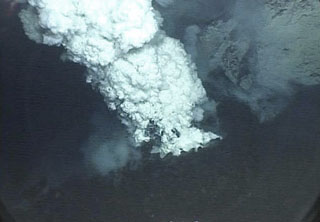Report on NW Rota-1 (United States) — June 2009
Bulletin of the Global Volcanism Network, vol. 34, no. 6 (June 2009)
Managing Editor: Richard Wunderman.
NW Rota-1 (United States) Ongoing eruption has created a new 40-m-high cone
Please cite this report as:
Global Volcanism Program, 2009. Report on NW Rota-1 (United States) (Wunderman, R., ed.). Bulletin of the Global Volcanism Network, 34:6. Smithsonian Institution. https://doi.org/10.5479/si.GVP.BGVN200906-284211
NW Rota-1
United States
14.601°N, 144.775°E; summit elev. -517 m
All times are local (unless otherwise noted)
An oceanographic research expedition during 3-17 April 2009 visited NW Rota-1 submarine volcano, located about 100 km N of Guam in the Mariana arc. Scientists visited the volcano with research ressel Thomas G. Thompson, making dives with the Jason remotely operated vehicle (ROV). The volcano was erupting almost all of the time with varying amplitude. This volcano was previously observed erupting during ROV dives in March 2004 (BGVN 29:03) and April 2006 (BGVN 31:05) on National Oceanographic and Atmospheric Agency (NOAA) Ocean Exploration expeditions, and by the Japanese in October 2005 and February 2008 (<BGVN 32:02).
A hydrophone deployed from February 2008 until February 2009, operated under the direction of Robert Dziak, measured almost continuous signals from the volcano during the 1-year period. This hydrophone will record data for another year, but it lacks telemetry, so NOAA intends to retrieve its data in 6-12 months. Prior to the deployment of the hydrophone activity was observed using a ROV only during brief visits.
On the expedition blog, William Chadwick noted that with NW Rota-1 apparently nearly continuously active since at least 2003, the volcano can provide a natural laboratory for learning about underwater eruptions, how submarine volcanoes grow, and how they affect the ocean environment. Scientists are able to get close to the eruptive vent because the pressure of the ocean above keeps the energy of the eruptions subdued, allowing them to gain a view of what is happening in the vent. For example, scientists watched lava slowly being pushed up and out of the eruptive vent while the sea floor shuddered and quaked and huge blocks were bulldozed out of the way to make room for new lava emerging from the vent.
The volcano had grown considerably since 2006, producing a new cone ~40 m high and ~300 m wide. Despite the ongoing eruption, with ash and rocks falling everywhere and an extreme chemical environment, a thriving ecosystem was present. The population of animals and microbes had both increased relative to 2006 and become more diverse, including new species not yet found elsewhere.
At the end of the 2009 cruise, an array of instruments (hydrophone and chemical sensors) was left to monitor events over the next year. Moorings on the flanks will look for landslides and debris flows. Chadwick's group plans to return in 2010 to continue investigations. On his blog site are some video highlights from the 2009 expedition showing activity at the Brimstone eruptive vent at the top of the new cone.
Geological Summary. A submarine volcano detected during a 2003 NOAA bathymetric survey of the Mariana Island arc was found to be hydrothermally active and named NW Rota-1. The basaltic to basaltic andesite seamount rises to within 517 m of the ocean surface SW of Esmeralda Bank, 64 km NW of Rota Island and ~100 km N of Guam. When Northwest Rota-1 was revisited in 2004, a minor submarine eruption from a vent named Brimstone Pit on the upper south flank about 40 m below the summit intermittently ejected a plume several hundred meters high containing ash, rock particles, and molten sulfur droplets that adhered to the surface of the remotely operated submersible vehicle. The active vent was funnel-shaped, about 20 m wide and 12 m deep. Prominent structural lineaments about a kilometer apart cut across the summit of the edifice and down the NE and SW flanks.
Information Contacts: William W. Chadwick, Oregon State University and NOAA Vents Program, Newport, Oregon; 2115 SE OSU Drive, Newport, OR 97365 USA (URL: http://nwrota2009.blogspot.com/); Robert G. Dziak, Oregon State University and NOAA Vents Program, Newport, Oregon; 2115 SE OSU Drive, Newport, OR 97365 USA.

